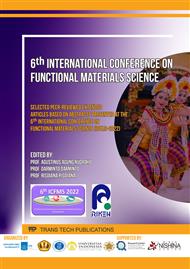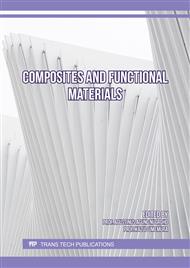p.93
p.99
p.105
p.111
p.117
p.123
p.129
p.139
p.145
N-Doped Graphenic Carbon Derived from Coconut Shell as n-Type Semiconducting Layer
Abstract:
The presence of N-dopant in Reduced Graphene Oxide has contributed to the change of their optical band gap. In this research, this mechanism has been implemented to synthesize nitrogen-doped graphenic carbon (NGC) proposed as an n-type semiconducting layer. The graphenic-based carbon (GC) was derived from coconut shells by a green synthesis method. The two sources of nitrogen dopants were prepared from ammonia water (NH4OH) and urea (CH4N2O). Synthesis of NGC was conducted from GC and a particular dopant with a ratio of 1:20 and 1:40 by wet mixing. Then the NGC solution was deposited onto a 1x1 cm2 glass substrate using a nanospray method to form a layer. X-ray diffraction (XRD) of NGC film has indicated an amorphous characteristic of the film. According to Energy Dispersive X-ray (EDX) spectroscopy, the presence of nitrogen as a doping material in the GC was successfully demonstrated. The SEM cross-section image has performed the NGC layer on the substrate. Absorbance analysis from UV-Vis spectroscopy also explains the occurrence of electronic transitions, both in the form of a solution and a layer of NGC material. The further analysis explained that the optical band gap of the NGC material ranged from 1.66 – 1.86 eV, which exhibits the semiconductor characteristic of the NGC material.
Info:
Periodical:
Pages:
117-122
Citation:
Online since:
July 2023
Keywords:
Price:
Сopyright:
© 2023 Trans Tech Publications Ltd. All Rights Reserved
Share:
Citation:



